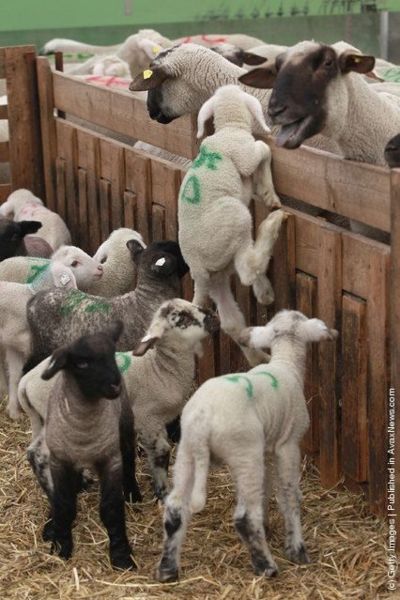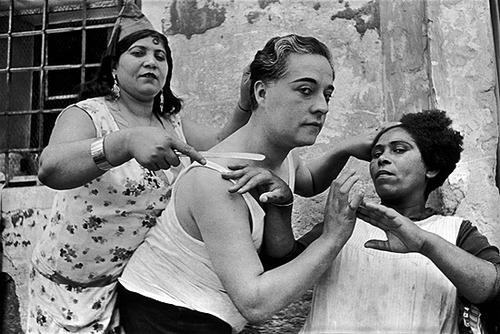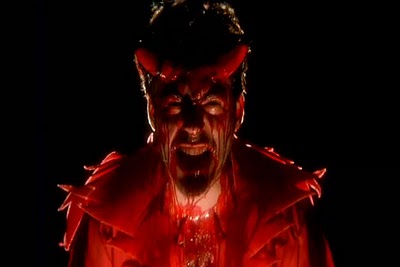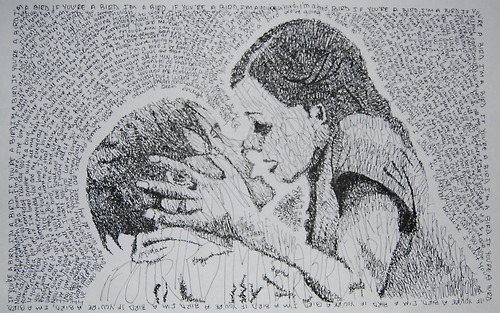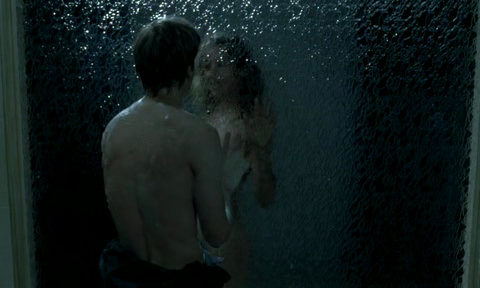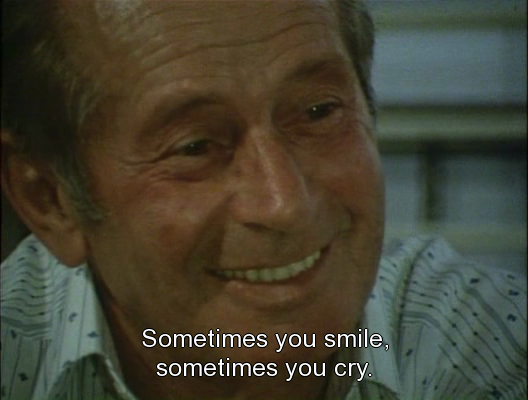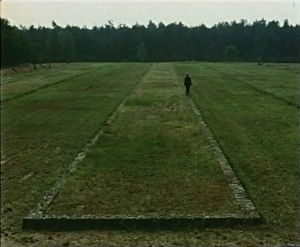
On absence and imagination in documentary film: An open discussion with Chantal Akerman
Akerman: Film is a heroic work, compared to installations, where you can see the result right away, sometimes after making a single gesture. When you make movies you only see the results of your work much later. Most of the time, even for experimental films, you have to write something in order to get money. I know what kind of person is going to give me money for a documentary, and in fact I write for that person, so I have to go into his mind and guess what kind of writing this person wants. There is only one person in France who can give me money for something like an experimental documentary, so I write for his head – later maybe I do something else, and even if I do he says ‘It’s exactly like your writing!’. A Couch in New York was another kind of work entirely, a commercial work. I loved writing it, it was easy for me, but I was writing for different people. Sometimes I’m wrong. I wrote a beautiful text about the Middle East, not immediately political, I didn’t want to talk about the Jews and Arabs, but something like my film From the East. I wrote an enormous text, they didn’t understand it. In a documentary I never know what I will do. I go there with no plan. In a way it’s terrifying.
Audience: But isn’t there a story somewhere, like with James Bird in South…
Akerman: I just wanted to make something about south. The James Bird story happened months after my decision to make something about the south. In From the East there is no story. So it’s frightening because you don’t know what is going to happen. You have to be so attentive to yourself. You are in a little bus with three other people. You have to try to totally ignore them, nothing should interfere between you and what you see. You have to be totally open like a sponge. You start to shoot something, why that? What’s going to happen with it? How it is going to take place in the movie, you have no idea. So many times, I have just been lucky, I was there. You have to be very confident, it asks much more confidence to go with no sheets of paper. In another sense it’s very exciting, too. Until the very end of the shoot you don’t know how those shots are going to fit into a movie, and whether there will be a movie. After we did South I thought when we came back from the shoot that we probably had something but that I would have to go back and shoot for three more months. I said to my editor, ‘Let’s try to put it together to see what kind of things I would need to build something’. When we edited it, however, it was a movie and I didn’t have to do anymore. Everyday when we were shooting I was saying ‘there is nothing’.
Audience: People talking about your work often draw associations with Warhol, Bresson, Dreyer and Snow. Do you think any of these references help to understand your work?
Akerman: I’m closer stylistically to Dreyer than any of the others. For example, when you see some shots of Jeanne Dielman sitting and you just see her face, I would love to never have the truth of her. It’s a lost cause. The dream side of someone, which is also a lost cause, you want to reach that in a way. If it’s a wall face, then as another you can reflect or project things which are also very rich. In a way it’s really a tension between these things that I love to work with, a face like a wall where you can project, or a face that you think you can see inside.
Audience: This tension would seem to be something like that between writing and film, in writing there’s a sense of entering into an interior, and with film you are moving across the surface.
Akerman: When I was young my dream was to be a great writer. I did write a lot, but I was still so impressed by the great writers. I always say well at some point I will finish, I will not make any more films and start to write. It’s totally silly and subjective, but writing is the most impressive medium for me.
Audience: I remember thinking that South has a really writerly quality to it, because, very much like a sentence, each image only made sense in its being adjacent to the next image. It was like this accumulation of images that ended up gathering meaning, and history became ingrained in the images so that when you saw a static image later in the film it was deeply embedded within the context of the situation.
Akerman: Imagine if I had to write South. It would never be finished. It would be a book with no end, if you have to put everything in the book. As a filmmaker, you impose a time that you cannot be imposed when you produce a book to read. I think that reading is a freer act than viewing a movie, because you put your own rhythm into it. When you give someone a movie to look at, you take away ninety minutes of his life. It’s an enormous difference, and that’s what something I’m very preoccupied with in my movies. I think that my movies have a kind of violence in the way I use the time, a very subtle violence, and instead of being a violence of explosion, it’s a violence of implosion. It’s a violent act when I push a shot as far as I can until it is just unbearable, and then I give another shot and you breathe again. It’s a violence done to the body of the viewer, because it’s becoming a physical experience. When I saw Bresson for the first time, I couldn’t stand it, I was crazy about him immediately. Something violent happened to me. As much I as adore him, he violated me. This is not my goal, it’s what happens.
Audience: In class you said as an example that it’s much more powerful to show a tree than to talk about it…
Akerman: I wouldn’t say it’s more powerful, exactly. When you say in a book ‘there was a beautiful green tree.’ You don’t see it exactly, you can make it up. If you see a tree on the screen, and then you have a woman speaking about lynching, then it’s opening your imagination. It’s usually by the addition of another image which is an opening. You can’t make images about the camps, for example, because that would be it. A book of that won’t close your imagination. You can write a book about the camps, it won’t ever be finished, unlike if you made a film. Images in succession can open your imagination, but an image by itself tends to close it off.
Schirmacher: The ‘closing’ argument is a typical argument in criticism of visual culture, it’s true for people raised in a literary culture, but it may not be true of people raised in a visual culture. For example, one of my favorite movies, Natural Born Killers had more images and faster shots than ever had been used before. People said ‘it’s impossible to get’ but it’s not true. There is a generation which can handle the so-called ‘closure’, for them it’s not a closure, there’s no image anymore on its own, every image only calls over another image.
Akerman: That’s what I was saying.
Schirmacher: You were saying the image has the power, and I agree to some extent, to close your imagination.
Akerman: But by itself! It’s not the same as with two images in tension together.
Schirmacher: There is no other definition of imagination than that it calls for another image. When I read, it’s also a stream of images going through my head. In a film it’s the same, it doesn’t limit my power to change images. It only makes it harder, I understand that, it makes it harder in a certain way because the images seem to be more impressive. But this is for people who are not used to a visual culture.
Akerman: I don’t think that people have changed so much, first of all, and I take my mother as the best example. She can take everything, maybe not images about the camps. That’s the real point about images. What are you allowed to show about the camps? That’s the biggest thing a filmmaker should ask himself. It’s the same problem whether you’re talking about documentary or fiction.
Audience: I’ve heard this argument a lot, that the image inspires much less in the way of imagination, but I don’t think that’s true, especially in some of the things we’ve seen this week, particularly the scene in ‘South’ with the rope. Part of the reason that’s so moving is because the way you film your movies gives the audience a lot of time to think about other things. As you’re traveling down that road, all of us are thinking about images we’ve seen before, the event itself…
Akerman: That can’t be done in writing. You can feel the same thing but it’s totally different strategy.
Audience: I think in a way it’s sort of the same nebulous, it’s just a different way of coming in at it. Instead of providing a couple of words that inspire you to go beyond, you supply a couple of images. I think there’s a sense sometimes in criticism that the image is somehow explicated, that you can’t imagine a different kind of tree because the tree you see is the tree you get.
Akerman: If I would have shot the scene of the three kids killing the black guy, I think it would have been much less powerful.
Audience: We’re talking about visual images, but precisely in film duration is an aspect. So the singularity of the tree shot opposed to the tree described is one component of visual culture. The singularity of the tree or that road with that duration in which your mind plays over it, rejects it, wanders away, comes back, then that road becomes more and less symbolic through that duration. I don’t think the text versus image argument can be properly delineated unless we know if we are talking about visual static or visual duration.
Audience: I’d like to hear you speak a little more about the physical violence that you feel you do to the viewer. I feel you’re very coercive in your filmmaking. As you’re planning your shots are you in a way choreographing the more visceral response of the viewers?
Akerman: I do it for me. For example, when I edited The Captive I tried to make it as tense as possible, so that you are swallowed by it, you can breathe less and less and less.
Audience: Right when they’re on the road, driving to the sea, that tempo is so intense that I felt like she had to die at that point, it felt like it had to explode.
Akerman: That’s narrative, but there’s also something physical. I think what is more coercive is not so much what you can think about the narrative, but what the film does to you physically. Forgetting about the narrative. I know it’s part of it but in a way there is something also abstract that works on you, you’re feeling like you can’t breathe. I want to return to discussing images of the camps, because the Americans took some images of the camps when they arrived there. When you see those images, they are totally frightening and horrifying, of people totally destroyed. With the image alone it is not possible to be totally aware of what it was for the people to be in that situation. In a way images are foreclosing, and it’s totally right for an extreme case, because images will never say what the people have gone through. In a way that’s why you should have other strategies to speak about it.
Audience: You actually have geography stand in for this thing that’s heavily tinted with this history. The weight of history is so present that the tree is the lynching tree of the South, there’s many referential meanings, histories, personal relations.
Audience: Your experience of going to the concentration camp and seeing the whole thing in images and not being able to film it because of the experiences of the people who went through the Holocaust is actually the contrast of what you said you were doing before in your film. There, you could focus on certain images and try to talk about the whole, try to reflect what you wanted to reflect. But you actually didn’t prefer that there, regarding the camps, because it was so intense?
Akerman: When you see history since the war from 1938 to 1944, what happened in Cambodia, Korea and Vietnam, it’s probably one of the most awful centuries. I think that as an artist it’s hard to work on that, even when you don’t think you’re working on it, it comes through. There are other strategies than filming the facts, in order to make people feel something and not just see something. Of course when they see they also feel but for me it’s the wrong strategy to film the Holocaust. I haven’t seen Schindler’s List. I think Lanzmann’s film was the best, I know some people say ‘Enough, stop that ‘Shoah’ business’, but I don’t think it will ever be enough. Especially since time is passing and there are new generations. We should do more. As a filmmaker it remains one of the main questions.
Audience: I think there’s another issue when it comes to filming something that is so devastating and also so encapsulated in time. With the American films of Jews in camps, there’s always a question of what was edited it out. I went to a performance and when we walked in the door everything was pitch black, then they showed on an enormous high wall projections of the outtakes from American concentration camp films, so pictures of piles of eyeglasses, hair, shoes, it was horrifying. To me I’d only ever seen the images of people suffering. When I saw the abstract images it was somehow more compelling as an artistic choice. Maybe you only have ten minutes as a news clip to put something out there.
Audience: I think there’s something else here that doesn’t have to do specifically with images. What you’re saying is that by showing something so specific you’re closing it off. This is the Holocaust. By suggesting something, a situation or a problem, because there have been many genocides since the Holocaust and there are many people who don’t want to acknowledge that. What’s important about watching South is the feeling that this can happen again, and that the situation is continuing.
Audience: Because it’s a feeling, not a concrete record in time and place. It’s not specific to one death, one event. That’s what becomes powerful about it. The end shot could be any road, not even just in the United States. There’s no fixed face in terms of the incident or the victimizers. You have reference points but the continuity between your films is this allowance, this range, this singular pointing to something which is a kind of violence to the viewer because you don’t let the viewer relax or go elsewhere. You remain with a respectfulness that is not normative in documentaries, you don’t claim that a story can be arrived upon, that the truth can be revealed, that the end will come.
Audience: So it’s strategy of not showing the event, but the spaces around it, the shadows that it casts.
Akerman: This is the case for both Resnais’ Night and Fog and for Lanzmann. Whatever doesn’t say, ‘That was it.’ Because that’s never it, it’s always more. If we want to confront what we’ve been through in the twentieth century then we have to speak about strategies of showing things.
